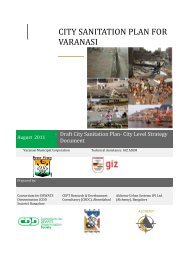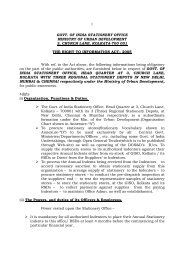CITY SANITATION PLAN - Ministry of Urban Development
CITY SANITATION PLAN - Ministry of Urban Development
CITY SANITATION PLAN - Ministry of Urban Development
You also want an ePaper? Increase the reach of your titles
YUMPU automatically turns print PDFs into web optimized ePapers that Google loves.
<strong>CITY</strong> <strong>SANITATION</strong> <strong>PLAN</strong> BAREILLY<br />
The key idea is to carry out a needs assessment within the existing infrastructure <strong>of</strong> service delivery.<br />
Following steps were identified before visiting the field:<br />
1. Identifying stakeholder groups and available channels <strong>of</strong> communication<br />
2. Focus Group Discussions, Interviews, Transect Walks<br />
3. Topic Guides and Probes prepared for each stakeholder group.<br />
4. Field assessment <strong>of</strong> communications needs to be carried out.<br />
These methods helped us to evolve a case study approach towards communication needs assessment<br />
for Bareilly city. Case study approach <strong>of</strong>fers the best possible method for evolving a Information,<br />
Education and Communications strategy for the city concerned. The random sampling based survey will<br />
be labor intensive and time consuming. Moreover, such a survey is likely to conceal extreme situations<br />
within the city. A case study approach utilizing information sampling can reveal much more through<br />
discussions with citizens on the margins and those on the frontlines <strong>of</strong> implementation.<br />
Stakeholders: Opinion leaders to be targeted as a high influence group both for interviews and<br />
implementation <strong>of</strong> communications strategies among residents, establishments and Nagar Nigam<br />
<strong>of</strong>ficials. Residents include all those living within city municipal limits; they can be classified as HIG, LIG<br />
and slum dwellers. Shopkeepers and commercial establishments constitute a separate group especially<br />
for generation <strong>of</strong> market waste. Specifically, in Bareilly a series <strong>of</strong> focus group discussions (FGDs)<br />
conducted with slum residents in various parts <strong>of</strong> the city. Interview and discussions included <strong>of</strong>ficials<br />
from various Nagar Nigam departments particularly Health & Sanitary <strong>of</strong>ficials, sanitation workers,<br />
prominent citizens, residents in middle class areas, NGOs involved in water and sanitation sector,<br />
shopkeepers, media persons etc.<br />
Locations for FGDs & Transect Walks were selected to represent the variety <strong>of</strong> samples. Slum locations<br />
can be classified based on local knowledge. Generally, slum in outskirts and those in interiors <strong>of</strong>fer two<br />
different typologies. The core city areas are predominantly by business class. Similarly there are slum on<br />
the outskirts are predominant with Muslim, SC or ST population.<br />
Probes for interviews and FGDs:<br />
ADMINISTRATIVE STAFF COLLEGE OF INDIA, HYDERABAD Page 24
















